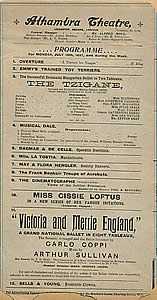Victoria and Merrie England

Victoria and Merrie England is an 1897 ballet by Arthur Sullivan, written to commemorate Queen Victoria's Diamond Jubilee – a remarkable sixty years on the throne. The ballet became very popular and ran for nearly six months.
Background
In honour of the Jubilee, Alfred Maul, manager of the Alhambra Theatre, asked Sullivan to compose a patriotic ballet. As the nation's preeminent composer, Sullivan was the natural choice to write the music. An alternate Jubilee composition, a poem submitted to Sullivan by the Poet Laureate, Alfred Austin, was never set.
Sullivan did most of the composing on the French Riviera, where he alternated between the music desk and the casino. Nevertheless, he took the commission seriously and produced one of his few successes in the decade of the 1890s. Victoria and Merrie England opened on 25 May 1897 and ran for six months at the Alhambra Theatre – a generous run for this type of piece – during which members of the royal family were said to have attended no less than nineteen times.
Description of the ballet
The composer's autograph does not survive, but Roderick Spencer of the Sir Arthur Sullivan Society has reconstructed the score from a composite of various sources, including earlier scores from which Sullivan drew, the piano reduction, and other clues in letters and press reports. Sullivan extracted three orchestral suites from the ballet, but only one of these survives. Sullivan's assistant, Wilfred Bendall, prepared the published piano reduction of the ballet.
The ballet does not have a plot per se. It consists, rather, of a series of seven historical vignettes in praise of Britain, such as "Ancient Britain," Christmas in the time of Charles II, and two scenes devoted to Queen Victoria. The score is a potpourri of characteristically English music, although it is probably too much of a pièce d'occasion to enter the standard repertory.
In the score, Sullivan re-used material from his Imperial March (1893) and his only other ballet, L'Île Enchantée (1864). The final scene depicting Victoria's coronation ends in a contemporary dance for soldiers from the various parts of Great Britain and its colonies and includes a counterpoint of characteristic tunes representing England, Scotland and Ireland.
Description of scenes
Scene I. (Prologue) represents a forest of oaks in the period of the Druids. Britannia is discovered sleeping. "England's Guardian Genius" enters and greets her. A procession of Druids and Priestesses appear, and sacred dances and various Druidical rites are performed. The High Priest notices the sleeping Britannia and prophesies her future greatness: all kneel before her.
Scene II. May-day festivities in the Elizabethan period. Coming of age of the Duke's eldest son.
Scene III. May-day festivities continued. Procession of mummers and dancers of various sorts. Historical quadrille, Morris dancers, Jack in the Green, May-pole dance.
Scenes IV and V. Legend of Herne the Hunter. Forest: a storm is raging. Herne's huntsmen enter with their kills. Herne appears and commands the hunt to be resumed. They all leave. The weather becomes calmer as the sound of the horns dies off in the distance. Nymphs enter and dance. Arrival of the Yule-log procession, with musicians, mummers, and peasants. They all dance around the log, and finally drag it off homeward. The nymphs and huntsmen return and join in a dance before Herne returns and sends them scattering.
Scene VI. Hall in an old castle at the time of Charles II. Christmas festivities. Servants arranging tables. Enter the Lord and Lady of the Manor. The cooks bring in the boar's head and baron of beef: dinner. Peasants and vassals enter, and the revels commence. Blind man's buff, jester's dance, etc. Father Christmas enters and distributes presents, and the scene closes with a dance under the mistletoe.
Scene VII. 1837: Tableau vivant of the Coronation of Her Majesty Queen Victoria in Westminster Abbey. 1897: Enter successively the English, Irish, and Scottish troops, who afterwards manoeuvre together. Enter Volunteers, followed by Colonials: various evolutions, sailor's hornpipe. Entrance of Britannia and final tableau.
External links
- Detailed description of the ballet
- Background of the piece and discography
- Summary of the ballet
- Review in The Times, 26 May 1897
- 1897 Programme and illustrations
- Piano reduction by Wilfred Bendall PDF (6.00 MiB). This also provides the synopsis of scenes and stage directions.
- Piano reduction by Wilfred Bendall at Wikimedia Commons